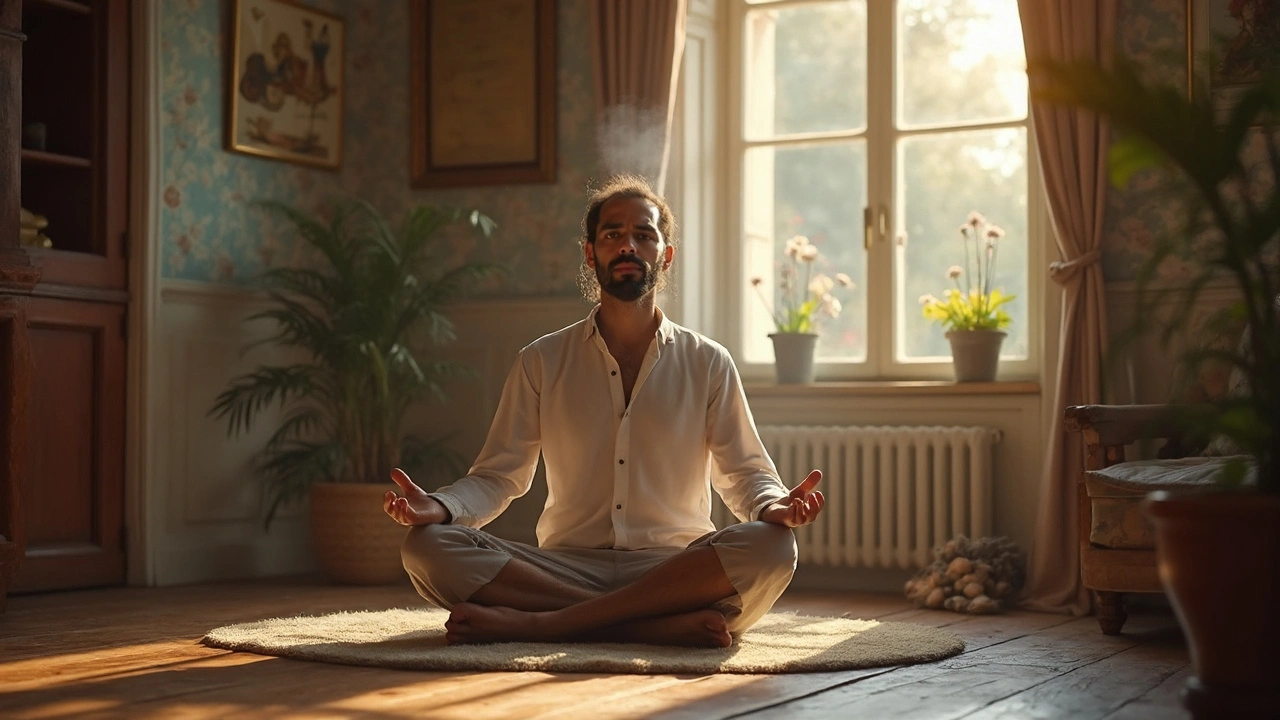
Ever feel like the world’s spinning just a tad too fast? You’re not alone. Life’s chaos has a way of creeping in, and stress becomes this sneaky companion you never really signed up for. The good news? Mindfulness can really shake up that unwanted guest list.
Mindfulness isn't just about sitting cross-legged on a mountain top—it’s more about being present, right here, right now, even when the laundry’s piling up and the kids are testing every ounce of your patience. By incorporating simple things like taking a few deep breaths or focusing on the sensations in your body, you can start carving out those precious moments of calm.
Let's break it down with some practical pointers. Start with some deep breathing exercises. Seriously, don’t underestimate the power of a good, deep breath. Try inhaling for four counts, holding for four, and exhaling for four. Do this a few times and see how your mind starts to slow down a bit.
- Understanding Mindfulness
- Simple Breathing Exercises
- Mindfulness Meditation Practices
- Daily Mindfulness Habits
Understanding Mindfulness
So, what's all this buzz about mindfulness? It’s not just some trendy buzzword. It’s all about being in the moment, soaking in what's happening around and inside you without rushing to fix or judge it.
Mindfulness roots back to ancient meditation practices, from Buddhist traditions, but you don’t need to get spiritual to reap the benefits. It’s about bringing attention to what’s going on right now. Practicing mindfulness involves engaging your five senses to take everything in.
Here’s a cool fact: studies have shown regular mindfulness practice can actually change your brain structure. According to a research conducted by Harvard, after only eight weeks of practice, people showed thickening in brain regions responsible for learning, memory, and emotion regulation. Kind of like giving your brain a workout!
Think of it as checking in with yourself without getting overwhelmed by everything else. Whether at work, stuck in traffic, or dealing with the morning chaos of kids refusing to put on shoes, mindfulness just asks you to pause and acknowledge the moment before reacting. It’s as much about what you don’t do (like panic or snap) as it is about what you do.
So, mindfulness is like hitting the pause button on life's craziness, even just for a second. That's why it’s a go-to for stress relief because you're training your brain to not get swept away in knee-jerk reactions. This skill can really change how you face daily challenges, one mindful breath at a time.
Simple Breathing Exercises
Alright, let's get into the nitty-gritty of stress relief through breathing. Breathing is kind of a big deal, right? But when you're stressed, you might notice your breaths become short and quick. Learning some simple breathing exercises can make a world of difference.
First up is the 4-7-8 method. This one’s a crowd favorite for a reason. Here’s how you nail it:
- Inhale quietly through your nose for four counts.
- Hold your breath for seven counts.
- Exhale completely through your mouth for eight counts.
Repeat this cycle four times, and you’re well on your way to feeling more centered.
If you’re in a rush (and who isn't?), the 4-4-4 breath is your go-to. Just inhale for four, hold for four, and exhale for four. Easy peasy but so effective.
Here’s a fun fact to hang on your fridge: According to a 2024 survey, 70% of people who practiced mindful breathing weekly reported lower stress levels within just four weeks.
Don't underestimate the simple goodness of these exercises. They're quick, you can do them anywhere, even during those chaotic supermarket runs.

Mindfulness Meditation Practices
Meditation might sound tricky, but trust me, it's not reserved for the yoga gurus only. It's about finding that sweet spot where you can just hit pause and be there in the moment. Mindfulness meditation is super practical for stress relief, and it’s been around in various forms for centuries. Let’s dig into some simple ways to get started.
First off, find a comfy spot where you won’t be interrupted. You don’t need a fancy cushion or a serene garden. The couch could work just fine—it’s all about comfort.
- Sit Comfortably: Rest your hands on your knees and gently close your eyes. If closing your eyes feels weird, just soften your gaze.
- Start Focusing: Bring your attention to your breath. Notice how it flows in through your nose and out through your mouth. Don’t worry, it’s normal if your mind starts wandering.
- Anchor Yourself: Whenever you catch your mind drifting, just acknowledge it and bring your focus back to your breathing.
- Set a Timer: For beginners, five to ten minutes works great. With practice, you might want to extend it.
There’s some science-y stuff backing this up too. Studies show that meditation can actually change the brain’s structure in positive ways. Say hello to better emotional regulation and decreased anxiety!
Try making it a habit. Same time every day works for many folks. Whether you slide it in before breakfast or during your lunch break, consistency is your buddy here. Over time, you’ll likely find you’re more patient, more calm, and way more in control.
Daily Mindfulness Habits
Bringing mindfulness into your everyday routine doesn't mean setting aside an hour to meditate—though if you can, go for it! It's about sprinkling small practices throughout your day. These simple habits can make a world of difference when it comes to stress relief and keeping a sense of calm amidst chaos.
Start with a mindfulness check-in first thing in the morning. Before you get out of bed, take a minute to notice how your body feels. Are your muscles tense? What about your mood? This small practice sets the tone for a mindful day.
During meals, try to engage in mindful eating. This means slowing down and really savoring your food. Notice the flavors, textures, and even the sounds as you chew. Not only is this practice great for digestion, but it also keeps you grounded in the present moment.
Here’s a big one for daily stress relief—the mindful pause. Whenever things get hectic, take a moment to pause. Close your eyes, take a deep breath, and tune into your surroundings. What can you hear or feel? Even a minute of this can help reset your mind.
Evening's a great time to reflect on your day. Jot down three things you’re grateful for. This habit not only wraps up your day on a positive note but also trains your brain to focus on the good.
- Morning Mindfulness Check-In: Spend a minute noticing your body and mood upon waking up.
- Mindful Eating: Focus on the sensory details while eating.
- Mindful Pause: Take a short mental break during stressful times.
- Evening Gratitude: Write down three things you are grateful for each night.
Remember, incorporating these techniques doesn’t require a lot of time. It's about being intentional with the moments you do have.





